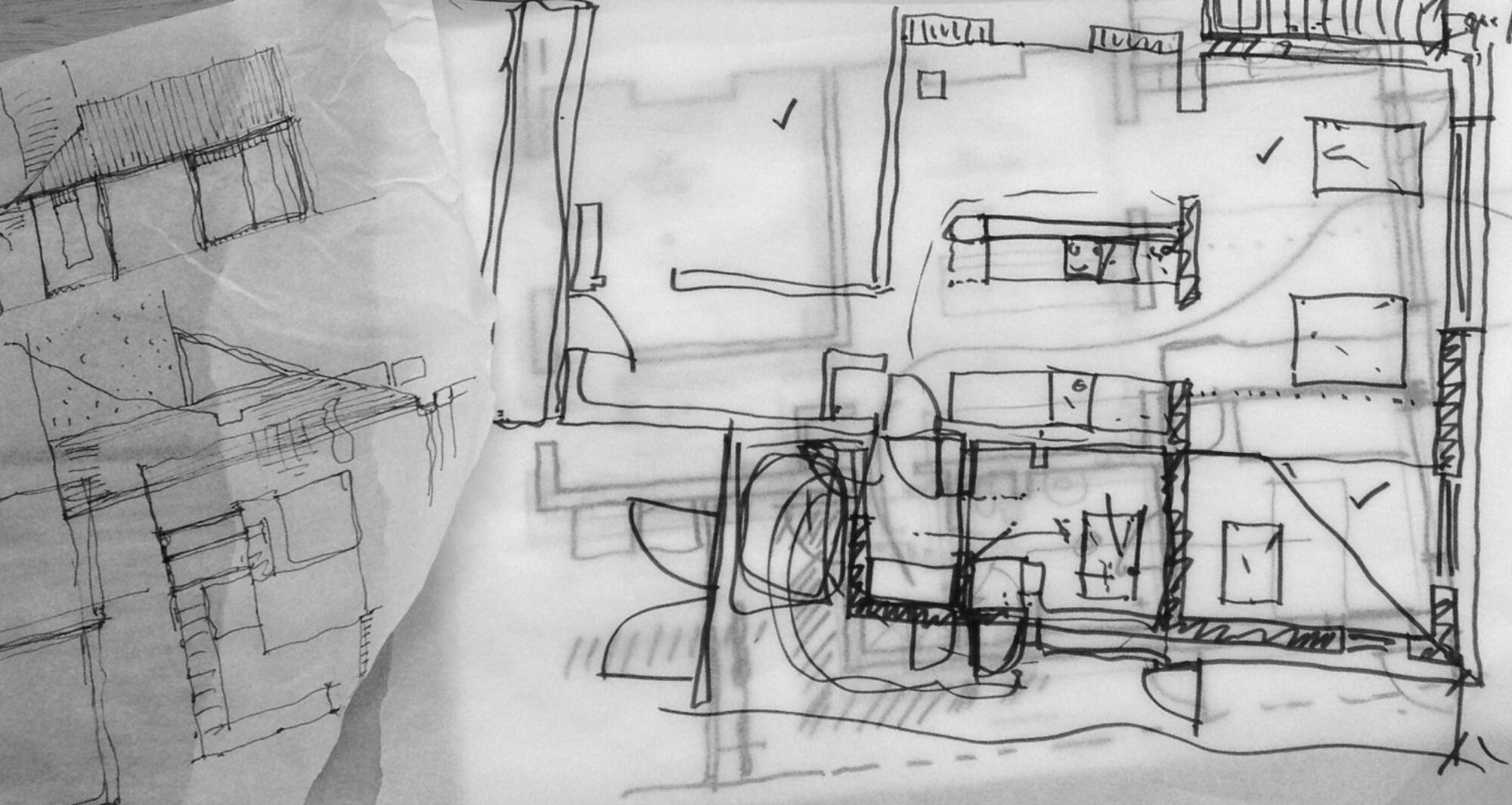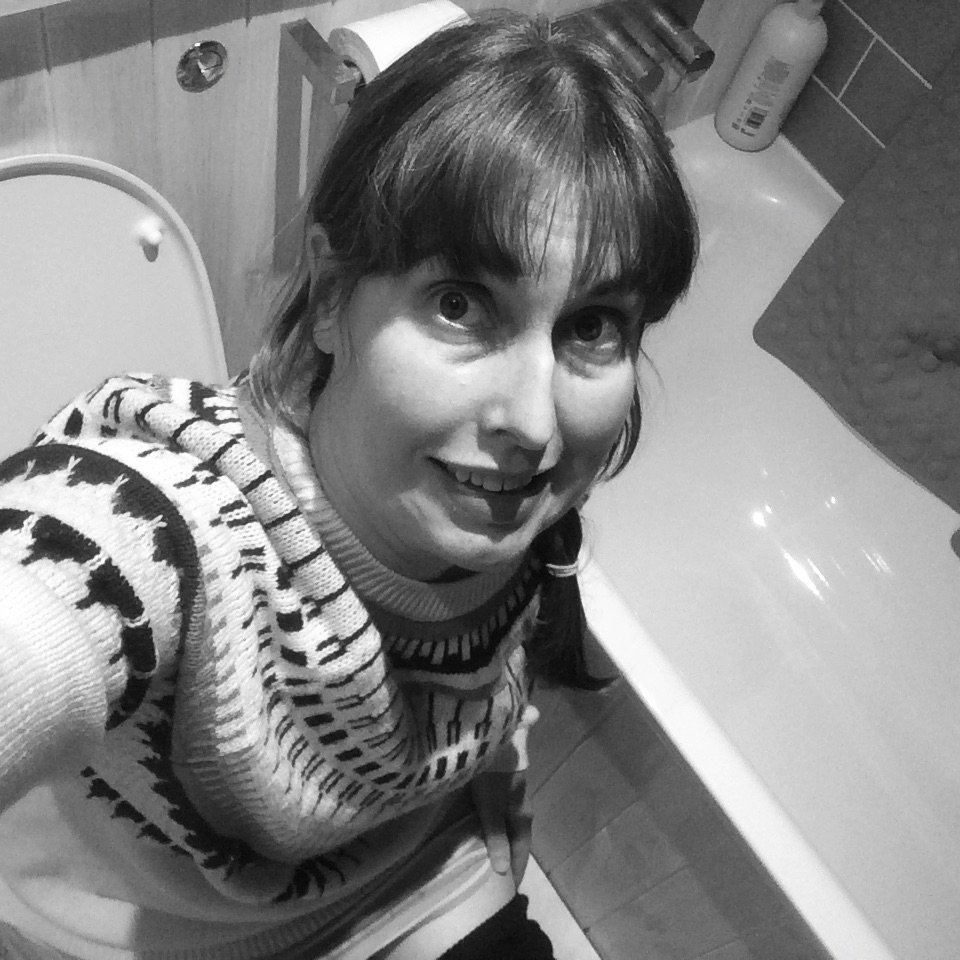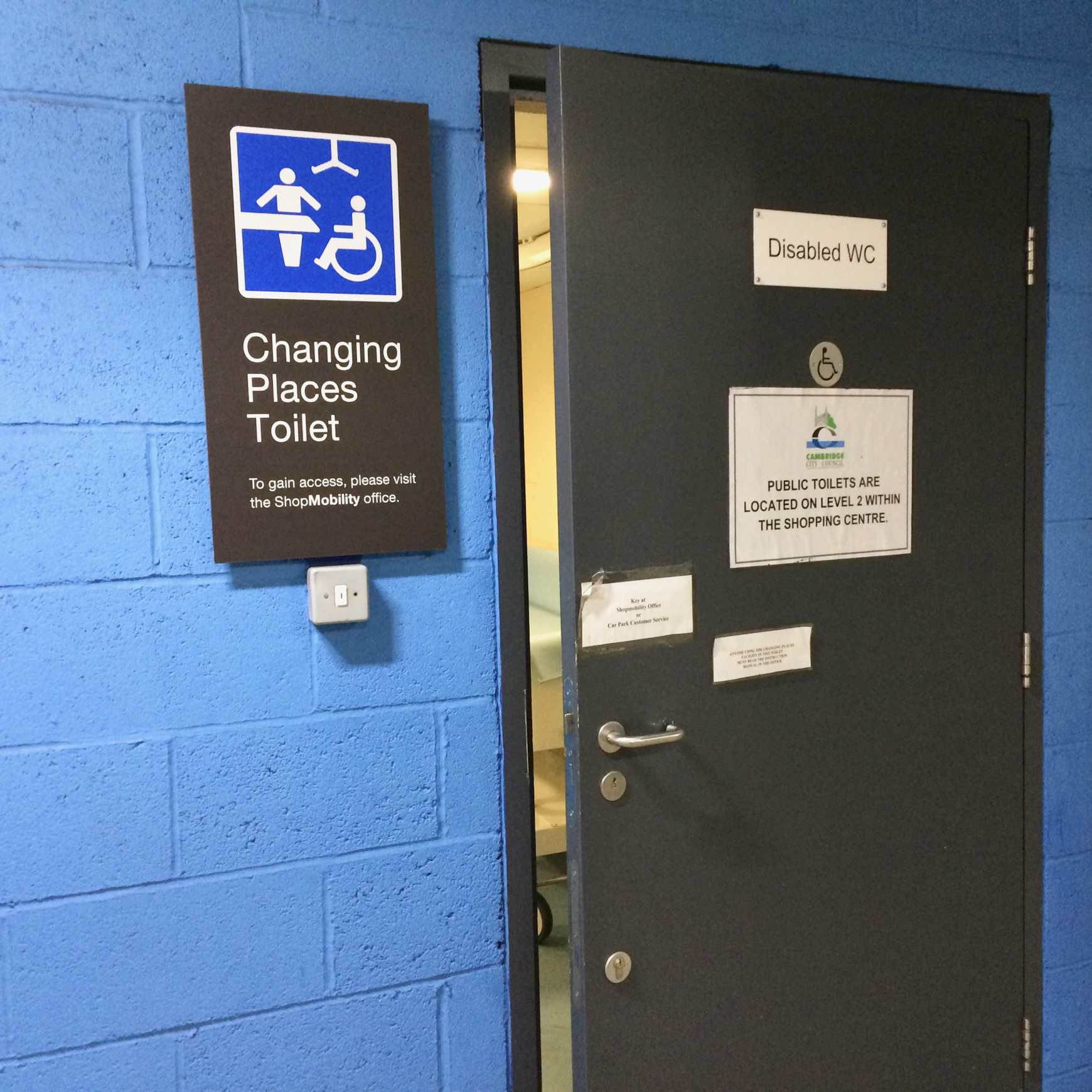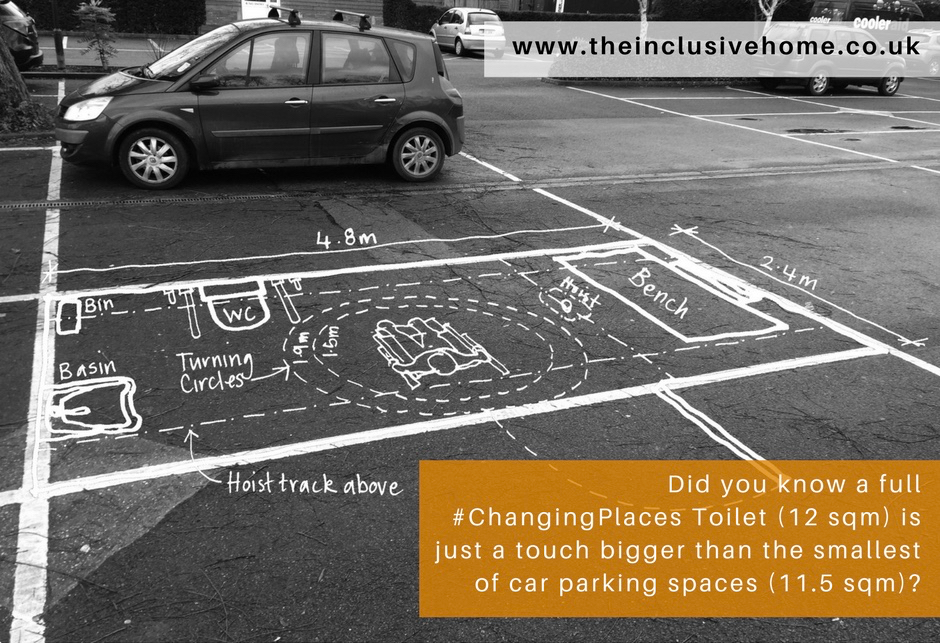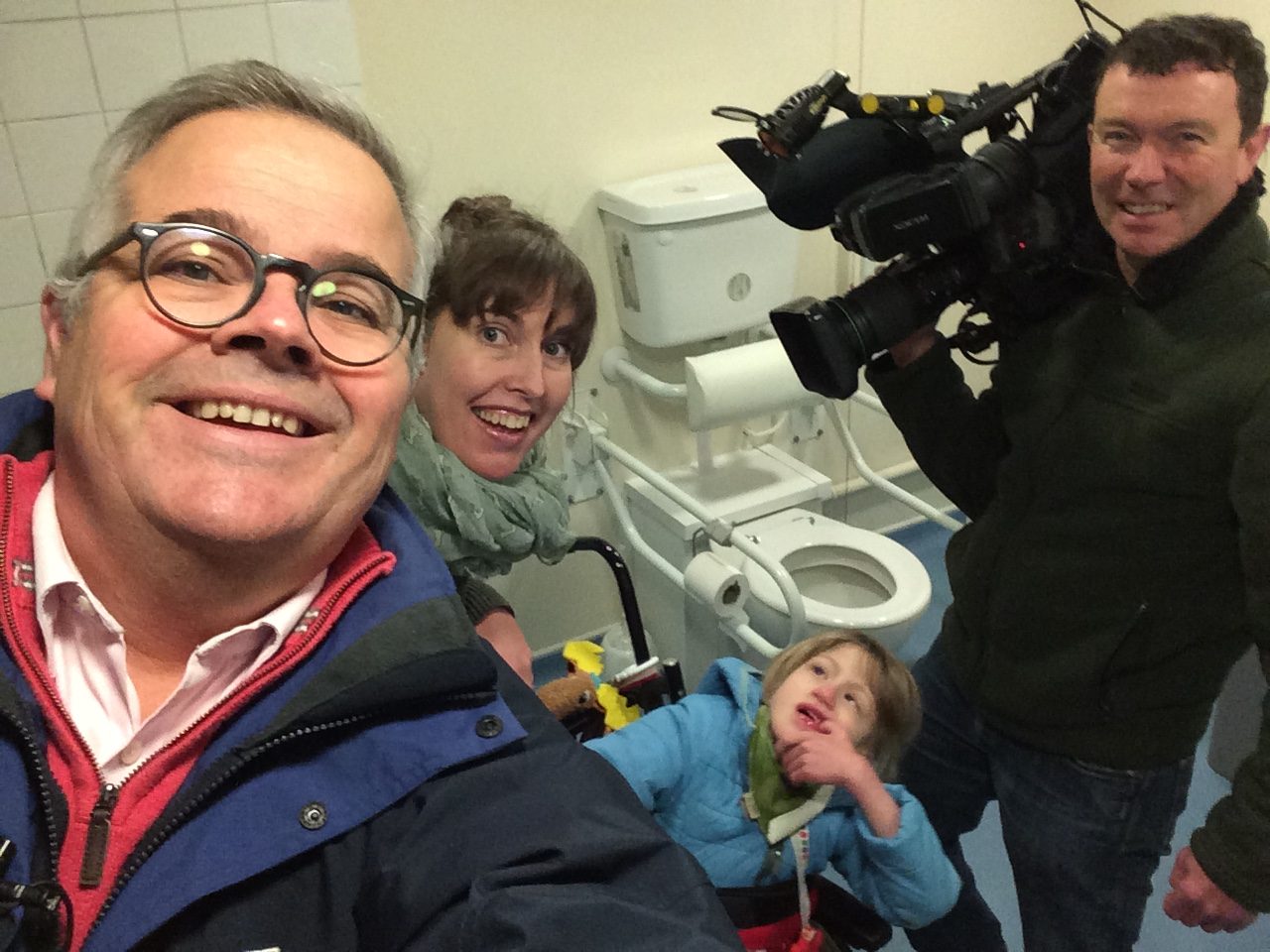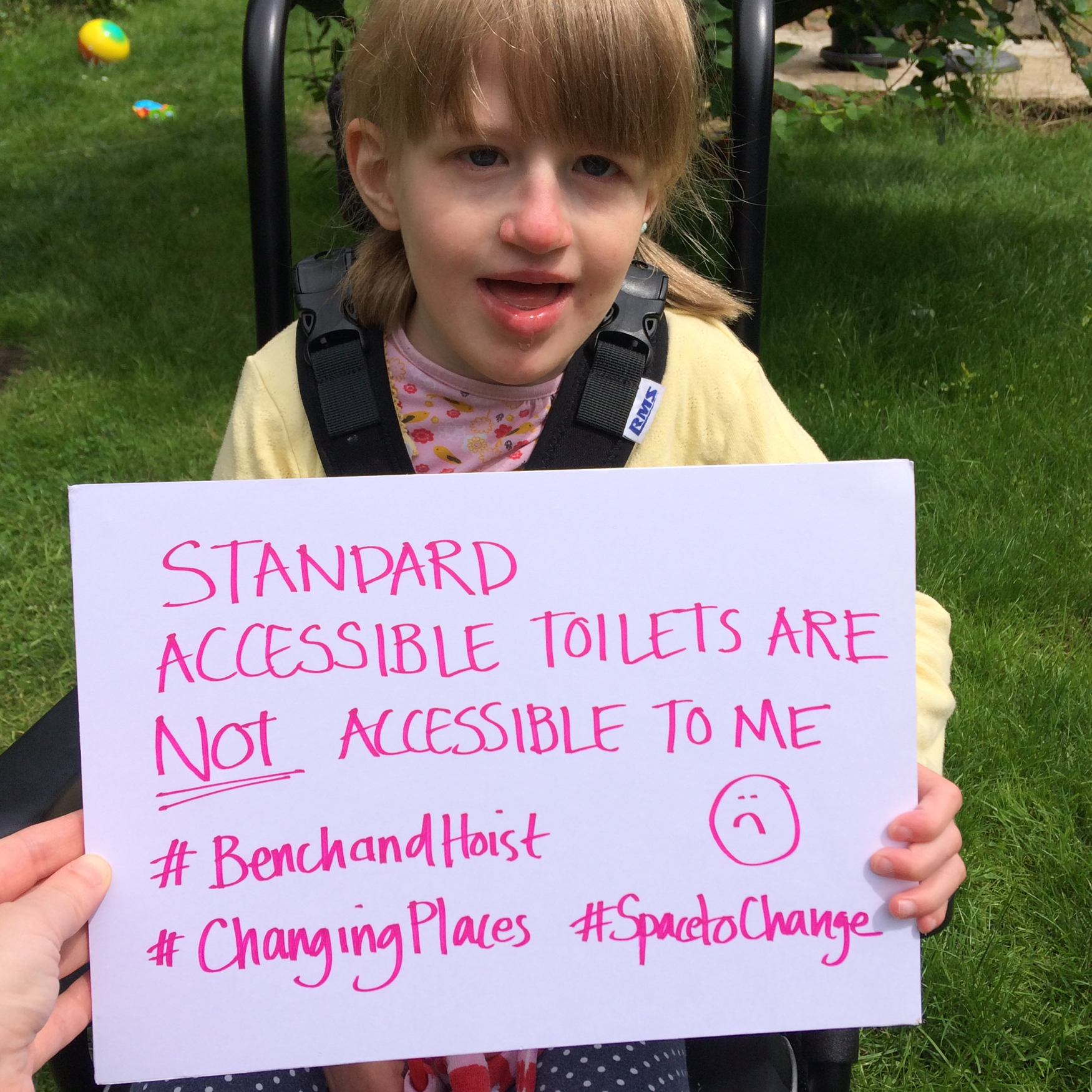The lengths this architect will go to
Dear Architects of the UK (and the rest of the world),
I want to talk to you about toilets.
I know the loos are not the most glamorous aspect of building design, but they are kind of fundamental aren’t they?
Would you ever dream of designing a publicly accessible building or place of work without one?
And of course any new building or refurb would have accessible toilets wherever there are toilets too?
But did you know that regular ‘wheelchair accessible toilets’ (doc M style toilets) are NOT accessible to all wheelchair users or even all mobile disabled people?
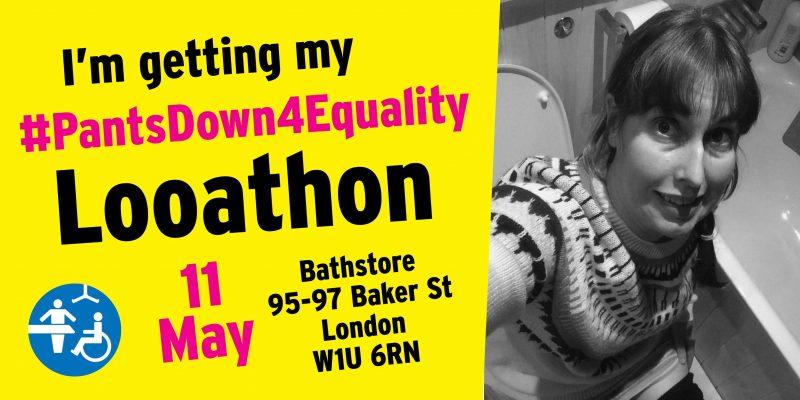
My daughter is one of those wheelchair users, which means our whole family’s movements are dictated by access to the most elusive type of toilet in the country.
In my home city of Cambridge (a vibrant, tourist destination) there is only one, registered changing places toilet in the city centre. Yes, just one toilet in the whole of Cambridge that my daughter can use, other than the toilets at her school and a toilet at the hospital on the edge of town.
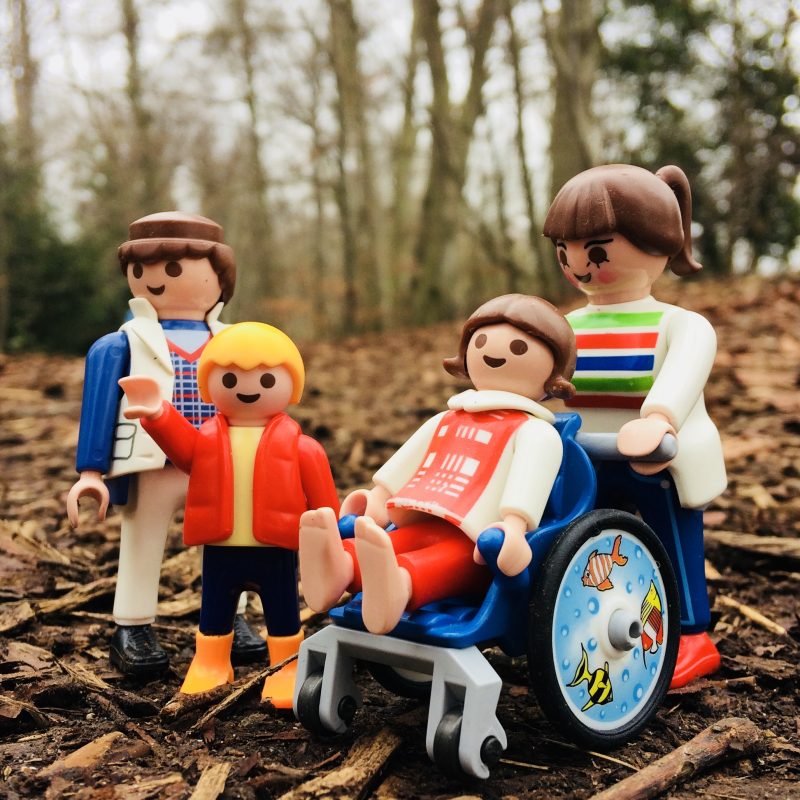 In London you can count on one hand the number of changing places toilets in the West End.
In London you can count on one hand the number of changing places toilets in the West End.
Therefore my family cannot visit the West End together.
We CAN visit the 2014 Stirling Prize winning Everyman Theatre in Liverpool, but we CAN’T visit the most recent Stirling Prize winning buildings (judged to be the best buildings of those years!?), or at least our visit would be hugely compromised, compared to other visitors, as we would need to leave as soon as it was time to use the toilet.
I carried out a survey monkey last year aimed at architects and building designers. Unfortunately (despite many regional RIBA chapters sharing it for me in their newsletters) I didn’t get a huge take up, perhaps because it’s not a very attention grabbing topic.
However, I think the results I did get gave some insight into why we still only have just over 1000 changing places in the whole UK.
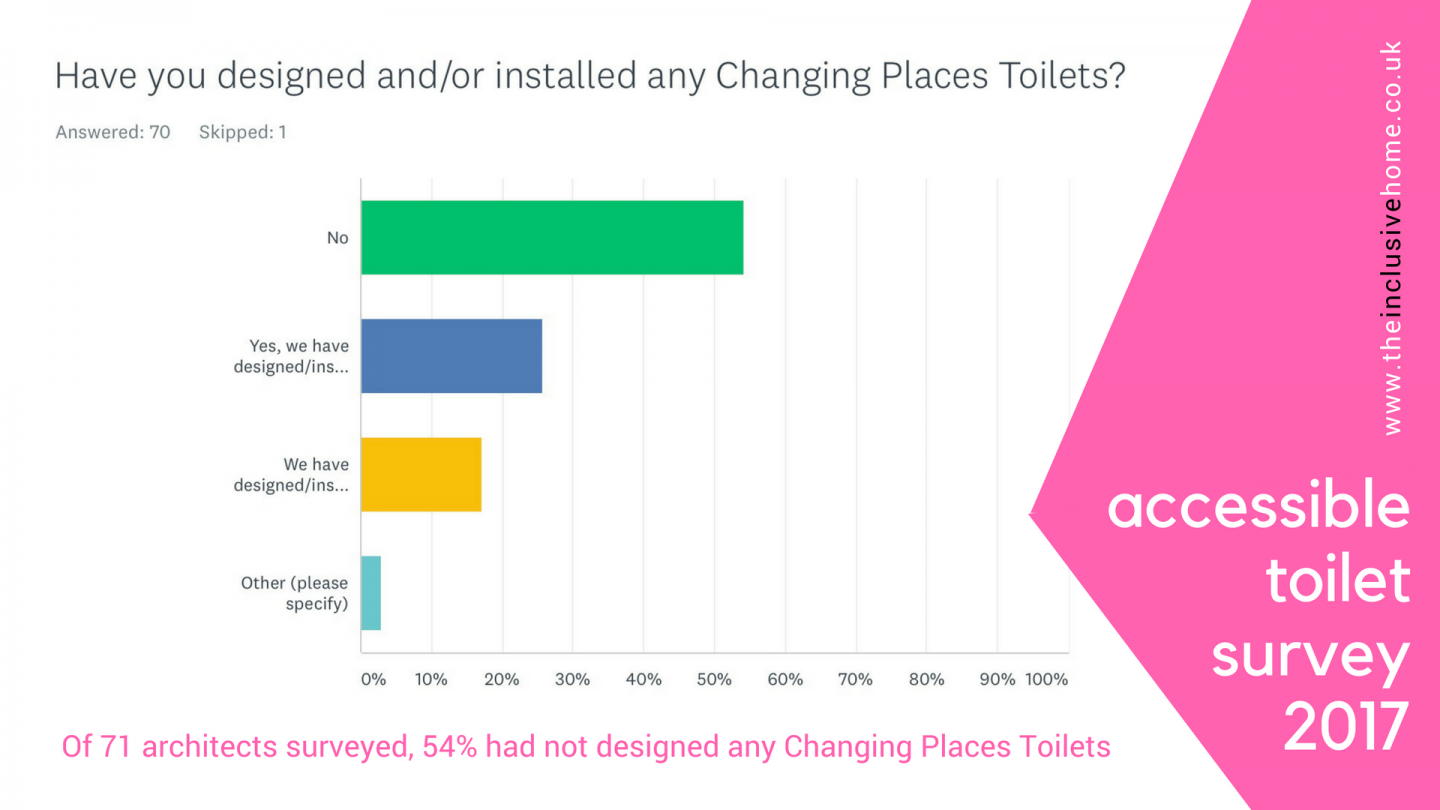
Of the…
…71 ARCHITECTS SURVEYED, AS MANY AS 54% HAD NOT INSTALLED A CHANGING PLACES TOILET…
…and those that had were mostly in community, care or educational settings (which are obviously very necessary), but very few in commercial installations at all, places where families like mine would like to be able to ‘go’ like other families (museums, cinemas, bowling alleys, theatres, department stores etc).
Personally I would love to see better guidance and I think there is mileage in there being more flexibility in the design of toilet standards in general, and that seemed to be echoed in many of the comments I received in my survey.
(I want to see some formal research on this topic, so if anyone can help in that department do get in touch!)
Following on from the success of her fantastic #LooAdvent campaign at christmas, amazing changing places champion, Sarah Brisdion, has organised a #Looathon with the great people of Bathstore in Baker Street on 11th May!
I deliberated about joining in, I am not an exhibitionist! However my first blog post on this topic was over 2 years ago, I’ve spoken to anyone who will listen! Yet still we have only one toilet in my home city and a handful in central London. And so, I have decided to join Sarah and a whole host of other amazing accessibility champions, volunteering to put ourselves in an undignified position because our built environment robs our friends and relatives of their dignity daily…
…AND SO I FIND MYSELF GOING TO THESE LENGTHS TO TRY TO RAISE AWARENESS, WITHIN MY OWN PROFESSION, ABOUT THE EXCLUSION MY FAMILY FACES IN MOST OF OUR PUBLICLY ACCESSIBLE BUILDINGS…
I would like to extend an invitation to any architects, the RIBA, the building design media & building professional bodies to come along and meet us to get a first hand view of why we need this change in attitude to toilet design! Also there will be a mobile changing places toilet at the event, a Mobiloo, so you will be able to see what is possible, even in the back of a van!
All I Want For Christmas Is A Loo
As it already appears to be Christmas advert and Christmas song season, it seems fitting to re-release this brilliant video from last year!
The amazing Sarah of Hadley’s Heroes came up with the idea to raise some awareness of the lack of changing places toilets whilst spreading some festive cheer, she rallied her brilliant friends and the collective of parent carers at My Changing Place and pulled this together just before the big day last year!
This year we’d like to try and spread the message for greater inclusion even further, in what better way, in the festive season, than in the medium of song!? Please watch and share and encourage all venues with customer and visitor toilets to have a think about exactly how accessible they really are!
(If you keep a lookout you’ll see J’s wee face appear a couple of times 😀 )
(Unfortunately the My Changing Places website is no longer active, but if you want to find out some more about the need for changing places toilets you can have a read of some of my earlier posts, for example check out the toilets illustrates why ‘disabled toilets’ are not for all disabled people and some other earlier posts here.)
You can also sign this petition to lobby government to make changing places legislation more definitive!
Inclusive British Standards?
The British Standard Institute’s document that deals with accessibility in buildings and the built environment (BS 8300) has been under review for some time and last month, the greatly anticipated (well by me anyway!) draft of BS 8300 for public consultation was published.
BS 8300 is a massive document with a wide ranging remit (excluding dwelling design), containing lots of essential information to enable designers, developers and service providers to take actions to enable access to our built environment for people across the full spectrum of disabilities (not just ramps and lifts – although of course they are very important!). Including this particularly welcome section about including Inclusive Design in the development process:
“An inclusive environment recognizes and accommodates differences in the way people use the built environment. It facilitates dignified, equal and intuitive use by everyone. It does not physically or socially separate, discriminate or isolate. It readily accommodates and welcomes diverse user requirements – from childhood to adulthood through to old age, across all abilities and disabilities and embracing every background, gender, sexual orientation, ethnicity and culture. It helps people to live independently and participate fully in all aspects of life.” (Clause 4, BS 8300 draft)
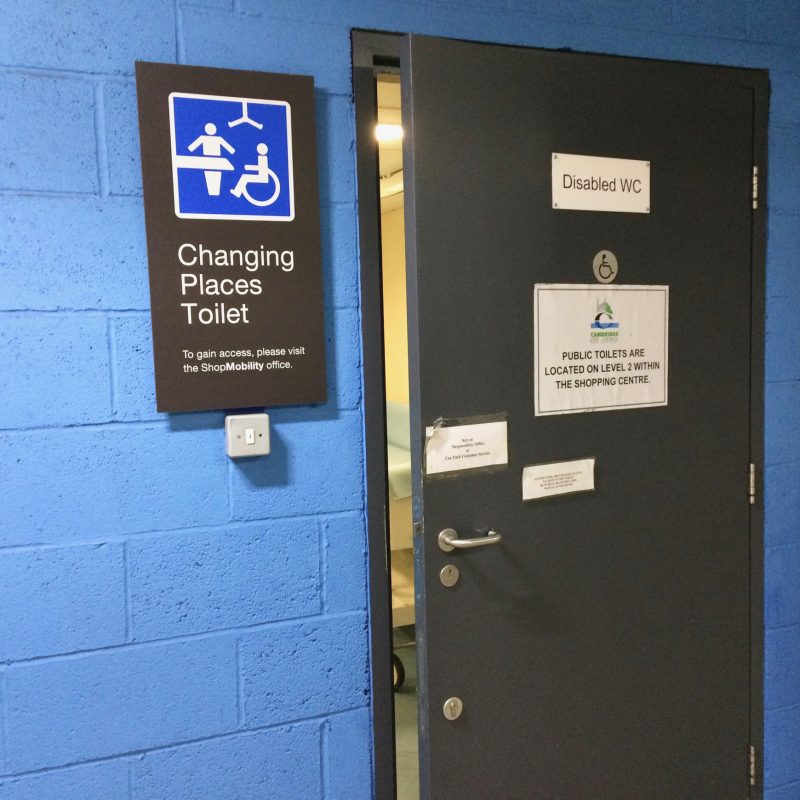 However (as any regular readers will know!), one of the aspects of accessibility that particularly impacts my family (and approximately 250,000 other individuals, plus their families and friends, in the UK!) is a shortage of accessible toilets with hoist and changing bench. The only description for this need currently in the BSi standards is called a Changing Places Toilet.
However (as any regular readers will know!), one of the aspects of accessibility that particularly impacts my family (and approximately 250,000 other individuals, plus their families and friends, in the UK!) is a shortage of accessible toilets with hoist and changing bench. The only description for this need currently in the BSi standards is called a Changing Places Toilet.
Therefore my primary focus so far has been on reviewing the sanitary facilities section and I’m afraid I’ve found the amendments extremely disappointing, and counter to the lovely inclusive statement above. It still reads to me as if changing places toilets have just been added on rather than included within the standards for sanitary provision.
I’ve laid out some of my initial thoughts on the accessible toilets section in a previous post, describing why we still feel Slightly Invisible and I will publish some more of my detailed thoughts on specific clauses (including my own suggestions for improvements) soon.
I know this legislation stuff can be a bit dry (downright boring?!) and jargon filled, but it is so important! So much of the challenge in campaigning is the drudgery of contacting individual providers, who may or may not be receptive to comments and many of whom throw back the old, ‘we’ve complied with all current legislation‘ chestnut.
In building legislation, there’s so much stuff to read, and it can be confusing even for those of us in the industry so it’s massively important that current legislation is clear, and also clearly fair (for the users and the providers).
So I thought it might help to try and explain what a BSi Standard (like BS 8300) is, and how it relates to other legislation and regulations…..
The explanation on the BSi website is:
“In essence, a standard is an agreed way of doing something” but is “designed for voluntary use”
“The point of a standard is to provide a reliable basis for people to share the same expectations about a product or service.”
The BSi standards are accepted guidelines, in some cases best practice guidelines for particular situations, products services, put together by a wide range of interested parties (in the case of buildings that is users, designers, consultants, developers, service providers etc).
They stand alongside, and support other relevant legislation, the key ones for building accessibility being the Building Regulations and the Equality Act.
Building Regulations
In England, the section that deals with accessibility is Approved Document M, Volume 2 (or Part M2 for short, Part M1 for accessibility in homes). Scotland, Wales and NI all have their own Building Regulations documents, but all have a broadly similar approach to accessible toilet legislation as Part M (hence the pet name for the standard style of accessible toilet being the “Doc M toilet” or the fittings being called the “Doc M Pack’).
As buildings, and their contexts, vary so much (from existing buildings to newbuild, from homes to offices and sports venues, tiny to enormous, hilly sites to flat…..) the Building Regulations are set out as an “Approved” way to do things, an approved way to meet a host of other legislation affecting buildings and people and the environment etc. You do not have to meet legislation in the way building regulations say so, if people want to, or find they can’t comply for some reason or another, there are concessions or alternative methods that may be approved on a case by case basis. However most developments do follow the regulations if they can, as everyone knows where they are then!
There is only a small mention of Changing Places Toilets in there, which references the BS 8300 document and the Changing Places Consortium guidance.
Building regulations are only enforceable at the time of development or refurbishment, so some people argue that changing them won’t help the situation for existing buildings.
The Equality Act
The Equality Act 2010 is a more overarching legislation that covers all equality issues from race to gender, employment to access. It does not set out specifics on how buildings should provide access, just that they shouldn’t put disabled people at a “substantial disadvantage”.
This, from the beginning of Part M of Building Regulations:
“Although the guidance in this Approved Document, if followed, tends to demonstrate compliance with Part M of the Building Regulations, this does not necessarily equate to compliance with the obligations and duties set out in the EA. This is because service providers and employers are required by the EA to make reasonable adjustment to any physical feature which might put a disabled person at a substantial disadvantage compared to a non-disabled person. In some instances this will include designing features or making reasonable adjustments to features which are outside the scope of Approved Document M. It remains for the persons undertaking building works to consider if further provision, beyond that described in Approved Document M, is appropriate.”
So although there is some wiggle room for developers and service providers in both the BSi Standards and the Building Regulations, they still play an extremely import role in setting out what is expected in buildings and venues and what would be considered a ‘reasonable adjustment’ under the Equality Act legislation. It’s therefore crucial that they reflect fairness to all, and in a clear way.
So if any aspects of accessibility affect you or someone you know, please do have a look at this draft document!
You can register with the BSi to view the draft and submit your own comments on the standards (until 13th August), as an individual or on behalf of an organisation, by entering BS 8300 into the search bar, here: BS 8300 for public consultation
You can find a selection of posts by other bloggers about how the lack of Changing Places Toilets affects them here
Slightly Invisible
Last week, during Carer’s Week, a twitter conversation between two of my campaigner friends made me immediately think of one of our favourite books, “Slightly Invisible” by the fabulous Lauren Child (the brand new Children’s Laureate!).
 In the story, Lola and her (imaginary?) friend, Soren Lorensen, drink an invisibility potion that her brother Charlie has made with his friend. Lola, of course, doesn’t become invisible but Soren Lorensen does…. Lola is adamant that she is also invisible and says:
In the story, Lola and her (imaginary?) friend, Soren Lorensen, drink an invisibility potion that her brother Charlie has made with his friend. Lola, of course, doesn’t become invisible but Soren Lorensen does…. Lola is adamant that she is also invisible and says:
“You can only see me because you know what I look like. You can’t see Soren Lorensen at all”!
Just as Ordinary Hopes said in her tweet, and her post The Invisible Boy, so many people just don’t ‘know what we look like’ either!
Perhaps they can’t see us because they don’t understand us or our needs? Perhaps we’re only slightly invisible and they can see some of our more obvious needs, like wheelchair access (not that that mean’s wheelchair access is a given!), but not our less obvious needs?
Designers, developers & service providers could be forgiven for not knowing what we look like. Nobody can ever know what other people’s needs are. Disability is such a massive spectrum, we are all slightly invisible to each other.
That is why regulations, standards and guidance are so important!
To help make everyone visible to those decision makers and providers of facilities….
At the end of last week the BSi (British Standards Institute) published a long awaited consultation draft of the proposed changes to BS 8300. This is the British Standard document which addresses accessibility in ALL aspects of our built environment (both outside spaces and in buildings).
I’ve been anxiously anticipating its publication (yes I am rock and roll!) and hope to publish some posts over the next few weeks on various topics covered that I have professional interest in or personal experience of.
The type of facility (or lack of) that impacts our family most, when out and about, is accessible toilets for people who can’t use the loo, those who need help to change continence pads, or those who can’t transfer to the loo without help of a hoist and/or more than one carer. So the only section of the BS I’ve read through so far has been the ‘Sanitary Facilities’ chapter….
….and I have to say anti-climax doesn’t even cover it.
I am really disappointed to see that there’s little change in relation to those who need help to use the toilet.
I don’t believe this draft of BS 8300 will help the decision makers see us any more than they did before.
I’ve yet to do a detailed compare and contrast, but my first thoughts are that there are still clearly two classes of disabled people when it comes to toilet provision.
The intro to the sanitary accommodation chapter (chapter 18) sounds great!
“Disabled people ought to be able to find and use suitable toilet accommodation no less easily than non‑disabled people. The space requirements for suitable toilet accommodation are generally driven by the requirements of wheelchair users, although the facilities might also be used by people with other impairments..” (Clause 18.5)
“At least one unisex wheelchair accessible toilet (see 18.5.3.1) should be provided at each location where toilet accommodation is provided for the use of customers, employees or visitors” (Clause 18.5.1)
So far so good! Wheelchair accessible toilets at each location where the other toilets are! Brilliant!
If only it meant all wheelchair users.
The ‘unisex wheelchair accessible toilet’ referred to is only suitable for those who can independently transfer to the WC. People who need hoist or carer assistance and/or who can’t use the loo at all and need somewhere to lay down to change continence pads cannot use these toilets.
In contrast to the above inclusive statement, the recommendation for where it’s appropriate to provide toilets with a changing bench and hoist (a Changing Places Toilet), is:
“Any larger building where the public have access in numbers or where visitors might be expected to spend longer periods of time is a suitable venue for a CP facility. Such facilities are particularly important in buildings that might offer the only suitable sanitary accommodation within a locality, or in buildings where public services are provided, such as those operated by local authorities. Some commercial facilities such as large retail and leisure premises might be suitable as they provide longer opening hours and are likely to have a regular cleaning regime.” (Clause 18.6)
The way I think this will be interpreted by business (and the way I think it has been so far!), is that we are a municipal ‘problem’ and businesses don’t need to bother with these ‘special’ facilities. It’s up to the government to provide them in strategic locations, not in locations where people actually are, or want to go. Only if you have a large building, that isn’t near another large building that already has one, do you need to bother thinking about it!
Reading this during Mencap’s Learning Disability Week, it brings it home to me that we have a long way to go to break free of the ingrained attitude in society. The older my daughter gets, the more it feels like people with complex needs are seen as other, even within the access community. That families like ours are expected to accept their lot, and be grateful if the council provide some facilities to enable them to get out of their homes occasionally.
Both the current and this draft of the BS for toilets with a bench and hoist are written in a very exclusive way. The only solution given being a changing places toilet, which is a combined WC and shower, and which should be locked and ‘normal disabled people’ and ‘regular families’ should be directed to the ‘normal toilets’ – I paraphrase here, but that is the jist of it. I really believe there are various design solutions which could create more flexible, inclusive facilities that could be more easily ‘sold’ to business as an asset for more customers/visitors/staff rather than an obligation (but I’ll blog about that later).
 This lack of provision is something that affects disabled people of all ages, but also their wider circle. You cannot go somewhere that your friend or loved one cannot access a toilet!
This lack of provision is something that affects disabled people of all ages, but also their wider circle. You cannot go somewhere that your friend or loved one cannot access a toilet!
I can only speak for our family. For myself and my husband as carers, and to represent our daughter who, quite literally, doesn’t, and may never, have a voice. However I feel that many of my campaign friends are at a similar stage of life to us, watching as our kids grow apart from society as they outgrow the baby change unit. Seeing the opportunities to visit places and join in activities with our wider family and friends slip away.
We don’t want to allow that to happen. We want to retain the opportunities for inclusion for our families.
We don’t want our kids, their siblings and friends to be limited by society’s views of disability.
We need to be visible to those people who make the decisions on the most fundemental of facilities (the toilet) on whether to include or exclude us.
A 21st Century Train Station?
There is a lot of buzz today about the opening of a brand new station in my home city of Cambridge! Cambridge North station!
I’m a big supporter of public transport, a bit of a transport geek, and particularly love all rails (trains, light rail and underground), I think I like the security of an obvious ‘stop’ to get on and off! I’m always a bit anxious on buses that I’ll miss my stop! Being near a rail station has always been on my house-hunting criteria list, and my husband commutes most days by train.
I’m therefore really excited to see development and investment in the railway, but I am also really, really sad that the station has not been built to provide facilities for ALL of their current and future passengers.
Earlier in the year there was a media buzz around the rail network for a different reason, when Paralympian Anne Wafula Strike, bravely spoke out about her horrible experience, when she was forced to wee herself due to lack of accessibility on the train. I wrote this post, Every Day is a Broken Toilet Day, at the time.
Anne Wafula Strike’s experience tells us that there are not enough accessible toilets in general, or in some circumstances the way to get to those toilets is or becomes inaccessible, e.g. when you’re on a train with a broken toilet and simply ‘hopping off’ at the next station isn’t possible as ramp access to trains has to be prearranged!
However, there is another layer to this that affects our family. Even when there is an “accessible toilet” available on the train or in the station, it’s extremely unlikely that it will be accessible to us.
A typical accessible toilet, a “disabled toilet” or sometimes known as a ‘Doc M pack’ toilet is designed with a whole host of different disabilities in mind, but the size of the room and position of fittings is predominantly designed to enable wheelchair users to access the loo. However, the term ‘wheelchair users’, in this context, really only applies to those who can walk a little, weight bear to stand and transfer or have the upper body strength to transfer from their chair to the loo.
Those who can’t transfer on their own to the loo or, like my daughter, need a place to lie down to have a pad changed, cannot access ‘accessible toilets’. The kind of toilet facility we can use are known as Changing Places Toilets, essentially a larger room which provides enough space for carer assistance, a changing bench and a ceiling hoist to enable someone to be lifted from their wheelchair to the bench and/or to the loo. Indeed the research carried out by the Changing Places Consortium estimates that accessible toilets are inaccessible to at least 1 in 260 people.
There was a lot of talk of making train travel fully accessible and promises not to allow what happened to Anne Wafula Strike to happen again, however…
No train that I am aware of has a changing places toilet type provision. The only way that we could freely access train travel throughout the UK as a family, is if all stations with passenger toilet facilities included changing places toilet facilities too, and if access to and from trains became more fluid, more spontaneous (i.e. you could easily hop off at the next suitable stop if you needed the loo!).
 The thing about going to the toilet, is that even continent people can’t always timetable the needs of their bladder or bowels, hence the need for customer and passenger toilets in publicly accessible buildings, around public services and public transport! If you have continence issues, there is even less predictability. You cannot book a long train journey with a plan to book a loo break at certain points, because you cannot predict when the need will occur! It is neither pleasant for the person needing a pad change to sit in a soiled pad for a prolonged period, and as a train is a confinded space, it is not pleasant for other passengers either if that person cannot alight at the next station and have their needs met in a timely manner!
The thing about going to the toilet, is that even continent people can’t always timetable the needs of their bladder or bowels, hence the need for customer and passenger toilets in publicly accessible buildings, around public services and public transport! If you have continence issues, there is even less predictability. You cannot book a long train journey with a plan to book a loo break at certain points, because you cannot predict when the need will occur! It is neither pleasant for the person needing a pad change to sit in a soiled pad for a prolonged period, and as a train is a confinded space, it is not pleasant for other passengers either if that person cannot alight at the next station and have their needs met in a timely manner!
So, for the moment, the barrier is still down on train access for us.
The reason I am bringing this up in relation to Cambridge North is that I’m reliably informed that Network Rail were made fully aware of the need for changing places toilets (indeed they have installed some in some of their very large stations) but they refused to consider this provision in this brand new station.
The reason given was that this was not an interchange station, and gave the examples of London Euston and Newcastle where they do have changing places toilets!!! That is a long way to go for a loo! I wonder, would they pay the fare for us to reach the London loo from Cambridge?
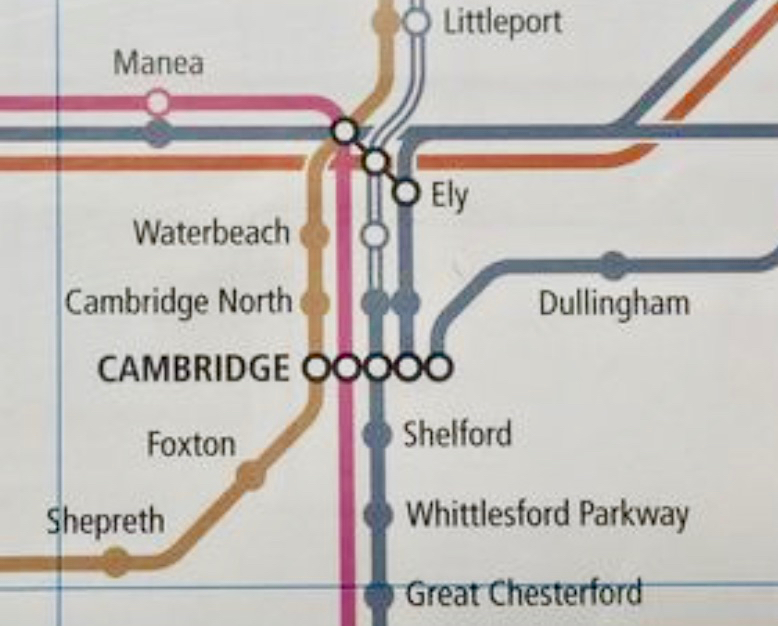 I would have a little more sympathy with this reasoning, if there was a changing places toilets at the nearby interchange stations on this line, namely Cambridge Station and Ely Station. Cambridge Station has had a lot of work done recently as part of the new station square development, but as far as I know, no signs of improved passenger toilets.
I would have a little more sympathy with this reasoning, if there was a changing places toilets at the nearby interchange stations on this line, namely Cambridge Station and Ely Station. Cambridge Station has had a lot of work done recently as part of the new station square development, but as far as I know, no signs of improved passenger toilets.
However as I mention earlier, if there’s little or no potential to provide changing places type facilities on the rolling stock, then how are disabled customers to plan rail journeys if there are not facilities on the station platforms that have facilities for other customers!?
Myself or my husband travelling alone, as independently mobile, and bladder and bowel continent, people we have the choice of using customer toilets at all large interchanges and many intermediate sizes stations as well as on all intercity and most suburban trains, but actually we’d also be able to find a customer toilet pretty easily near many stations in larger towns or cities if necessary, in local cafes, shops etc. However those with the least mobility, and the least control of their continence, have the least choice and the least provision. In Cambridge, you’d have to walk (or wheel) for about 20/30 minutes from the station, past a multitude of restaurants, pubs, cafes and shops (many with customer toilets) to the Grand Arcade in the city centre to find a changing places toilet.
So back to my question, is this a 21st Century train station?
I truly hope not, because if that’s the case the 21st century is no more inclusive than the last.
If we are really serious about enabling ALL disabled people to access train services, there either has to be suitable toilet provision for ALL people on the trains themselves or at ALL but the smallest stations.
Not enough space?
Quite often, when discussing changing places toilets with new people, the size of the room comes up, and often becomes a bit of a sticking point!
To be fair, in isolation, at 12 sqm a changing places toilet does sound quite large, particularly if you are comparing it to an individual toilet cubicle, or even a standard accessible toilet. But then that’s one of the main reasons many people need a changing places toilet rather than one of the other type of toilets, simply because they can’t get in to the smaller rooms!
(Follow this link to a post I wrote previously about how accessible the average accessible toilet is).
When people get stuck talking about the floor area a changing places takes up, it sometimes feels as though they forget that all toilets take up floor area (and cost money to install!) – even the inaccessible ones! But they do take up space, and quite a lot of it! If you visualise a standard women’s toilets for example, the cubicle is just one element, there’s also the space needed for the vanity unit, with bank of wash hand basins, and the circulation space in between the two. And then you’ll also have the mens loos, at least one standard accessible toilet (hopefully!) and perhaps (depending on the building type and location) a baby change or family room too, which is often a similar size to a changing places toilet!
All those other toilets have limited access, whereas a changing places toilet, is very accessible! Changing places toilets are generally considered the add on, taking up extra space, but I think we are looking at things the wrong way round.
If there’s only space for a few toilets in a venue, why not start with the most accessible and add the least accessible rather than the other way around?
I’m a bit of a numbers geek, so I decided to try and think of spaces that people know really well, to help visualise the area required by a changing places in context with something familiar, and, do you know, one of the simplest of things many of us use everyday is, give or take 0.5 sqm, exactly the same area as a changing places toilet!?
A car park parking space.
Not a blue badge space, or an on street parking space (which are actually a bit longer) or even the slightly more generous kind that some car parks now provide to accommodate bigger modern cars…. nope!…. a totally bog standard (excuse the pun!) minimum size car parking space is 2.4 m x 4.8 m, which is 11.5 sqm in area!
A space most of us take for granted.
Car parks occupy massive amounts of space (sometimes in multi-storey structures or excavated basements underneath buildings which involve reinforced structures, car ramps and all sorts of expensive engineering just to enable us to leave our cars occupying a space while we’re not even there!)! …. so when the reason given for not installing a toilet in a building or venue (a toilet that most people could use!), is lack of space, I really have to wonder…!
P.s. The above graphic isn’t about adding changing places toilets into car parks, its a comparison of the size of a changing places toilet in context with the size of a space we are all very familiar with! However it does bring to mind the image of those mobile toilets provided in trailers for temporary events! So if you are organising an event, please do take note that a changing places toilet does fit in a trailer too, and there are a couple of suppliers who can provide mobile options that you can hire to make your event truly accessible!
Every day is a broken toilet day
Well 2017 has begun with a lot of talk about accessible toilets!
I’m so, so, thankful for Anne Wafula Strike speaking out about her horrible experiences due to lack of accessibility on the train. A culmination of various things, a lack of facilities, a broken toilet, lack of independent access to and from the train, lack of assistance when needed…. lots of layers of accessibility fail.

The fact that this has hit the media is fantastic news to me and fellow campaigners, as so many people live similar problems everyday, and I wonder if maybe we’re seeing part of the solution – accessible design – moving into the mainstream forum?!
Toilets of course are not the most glamourous aspect of building design, but, unless you are just whizzing through, they are pretty fundamental to access. If you go anywhere to work, eat, drink, watch a show or a movie, view some art…. you go there assuming there will be somewhere to go to the loo. I’m not a big fan of a public loo, but I know I would be quite anxious if there weren’t any available!
I can remember once going to a restaurant (a very small one in London) and when we got there we were told all the loos were out of order, but they had made an arrangement with the pub a few doors down, for customers to use the loo there. A satisfactory short term solution!? But it did feel very odd to leave the restaurant, and your friends, mid meal and go out onto the street! I remember silly things going through my head, like should I put my coat back on? Take my bag and/or phone?
I also wonder now, would I have gone if I had known that would be the arrangement? Would I return somewhere if it was?
Fast forward a few years (or 10!) and this is now our everyday scenario.
My daughter J is 6 and my son W is 3. J has developmental & sensory disabilities which mean that she is a wheelchair user and also has continence issues, so wears pads (nappies).
Every day is a broken toilet day for her. Which means that, if we are out together, then every day is a broken toilet day for all of our family.
Anne Wafula Strike’s experience tells us that there are not enough accessible toilets, or in some circumstances the way to get to those toilets is inaccessible, (e.g. when you’re trapped on a train due to lack of ramp, you can’t just hop off to use one at the next station!) however, even when there is an accessible toilet available, it’s extremely unlikely that we’ll be able to access it.
The typical accessible toilet is designed with a whole host of different disabilities in mind, but the position of the fittings is predominantly to enable independent wheelchair users, those who can stand, weight bear or have the upper body strength to transfer from their chair to the loo.
But what if you can’t transfer on your own to the loo or what if (like J) you need a pad changed and cannot stand up to have it done?
Until recently W had the same toileting needs as J does now, and most places we visited as a family provided exactly the facility he needed. A changing table. And, as he was only 2, he fitted perfectly on the changing tables we found. J is 6. J hasn’t fitted on a baby changing table for some time, and even if there was a bench large enough to lay her on, she’s also getting to the stage where she’ll be too heavy to transfer without a ceiling hoist, a stage that many many older children and adults are at now.

 It’s estimated that accessible toilets are inaccessible to at least 1 in 260 people.
It’s estimated that accessible toilets are inaccessible to at least 1 in 260 people.
There is one toilet in our city centre (Cambridge) that we can use. Only one registered changing places toilet. In fact we did a little bit of filming with the BBC Look East in there last week! Oh, the glamour of TV!
It’s the only toilet in the city centre that isn’t ‘broken’ to us – but, brilliant as it is to have it available, it’s not in a location you would go. The only way to get to it is to leave the place you are visiting, eating, viewing and walk to the shopmobility office in a shopping centre car park. In fact, I do not know of a single place we could go in Cambridge where the toilet is accessible to us.
I’m really keen to understand why there’s not a greater range of facilities in more places. A more inclusive provision in buildings that people go to, places that people visit.
So if you’re in the building design, construction or management industries I’d be really grateful if you’d complete and share my survey to help me gather views on the accessible toilet guidance available, and any improvements that could be made in design and legislation. (Edited to add: Survey now closed)
I’m looking for feedback from people in all sectors of the building industry, whether you have specific experience or expertise in accessibility or not (in fact the wider the range of experiences the better!).
Why should we?
Why should we install a changing places?
I can understand that many people have not heard of Changing Places toilets. I understand there’s a valid argument that venues just don’t know about them. However once they do know….?
I worked in architectural practice up until 2010, just after the guidance was entered into the British Standards (BS 8300), and I honestly hadn’t thought about the building regulations ‘standard unisex accessible WC’ not being adequate for all disabled people. Don’t ask me how I didn’t know as it seems so obvious now, but it just hadn’t occurred to me what people would do if they couldn’t get onto the loo on their own ! How could someone help to lift them in that little room and without any hoisting equipment!? And what if you were not a baby (maybe you’ve not been a baby for decades!), but wear an incontinence pad and need assistance to change it? Where would you lay down?
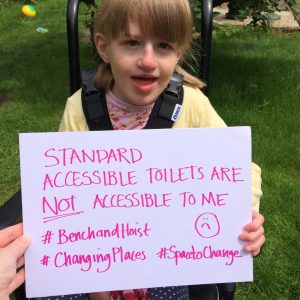 It wasn’t really until my daughter was growing too big for baby changing tables that I began to wonder if I was missing something, and of course when I began to look around I found the Changing Places campaign. A campaign that had grown out of the frustrations of a determined bunch of parent carers deciding to take action about this lack of provision.
It wasn’t really until my daughter was growing too big for baby changing tables that I began to wonder if I was missing something, and of course when I began to look around I found the Changing Places campaign. A campaign that had grown out of the frustrations of a determined bunch of parent carers deciding to take action about this lack of provision.
I was excited to find that they had secured a pretty comprehensive entry in BS 8300, recommending the type of buildings these facilities should be installed in. And there is also reference to this BS guidance, and to the Changing Places Consortium, in the Building Regulations relating to building accessibility (Part M).
However it soon became clear there really weren’t that many of them actually installed.
Ok so it’s a new standard? There will be loads in the pipeline right?
Now that the need has been identified and quantified in BS guidance, there will be lots of new buildings automatically including them, and lots of existing venues will start installing them…. right?….right!? Erm….no, not really.
Over the last year or so I’ve gotten to know a number of campaigners pretty well, several of them are fellow SWAN UK members with children with complex undiagnosed conditions, some have older children and some are adults who need the facilities themselves. Unfortunately their experience has been negative on the whole. Of course there are some exceptions and some lovely positive stories of venues, on hearing of the need, step up and even enthusiastically take steps to ensure a changing places toilet is installed in their new building or refurbishment. Some see the benefits of inclusion straight away without much, or even any, persuasion. Two such projects that spring to mind are Longdown Farm and Cornwall Services – both fantastic examples of how it should be, how I’d have expected it to be.
However the far more frequent response seems to be: “not our responsibility”. Even when confronted with the fact that their disabled customers & carers have to leave early, risk falls & back injury, lay on toilet floors or even not come at all, the fact that changing places are not compulsory, that there’s no minimum requirement to cater for ‘our kind’ of disability, means that venues see changing places as an extra. Something over and above what they need to provide. Their competitors haven’t had to do it so they don’t want to be the ones who have to spend the extra money.
I have to say I have a little sympathy for this. The changing places standard is significantly bigger than designers and developers are used to as an accessible toilet, and of course floor area = cost. Without clarity of who should install them, and in this financial climate, I can sort of understand individual organisations backing away from responsibility. My feeling is that there should be a review of the whole ‘suite’ of sanitary facilities we have in our regulations as minimum standards. I think there’s opportunity to have more inclusive options, for smaller family friendly venues for example, where perhaps the adult and baby changing areas are not put in separate rooms but a single family toilet area is installed, so the room will be used by a greater number of customers and business’ will feel there is more ‘value’ in if for them? But that’s another blog post I think!
As I say, these facilities seem to be viewed (by most?) as an ‘extra’, as something for a minority and not their responsibility to cater for, so thought I’d look at some figures I could find online which (I think!) illustrate clearly that’s not the case (although even if it’s just one person that’s being excluded, isn’t that one too many!?).
The Changing Places Consortium website tells us there are over ¼ million users in the UK who need a greater than the average accessible toilet, in a population of 65.1M (ONS).
So that’s (at least!):
1 : 260 people
1 in 260 may not sound like a huge number of people on first glance, but just to put that into a bit of context, here are some building venue capacity stats:
Blackpool Tower Ballroom (who do have a changing places toilet I must add – #IncLOOsion!) can accommodate:
- 900 people for a banquet (statistically 3.5 changing places users per banquet),
- 550 for a dinner dance (statistically 2 changing places users per dinner) ,
- 1100 for theatre performance (statistically 4 changing places users per performance).
Wembley Stadium (who, again, do have a changing places toilet) has:
- 90,000 seats (= statistically 346 people per match needing CPs)
- 2,618 toilets (including 1 Changing Places Toilet!) in this one (granted, very large!) venue, yet there are only *895 Changing Places in the WHOLE UK!
For an area with such high density of entertainment & tourist venues, the west end of London has particularly poor provision of changing places, and I don’t mean to single out these two over any other (because they ALL should have one) but, for example:
The Royal Opera House auditorium seats:
- 2,256 people ( = statistically 8.7 people/performance needing CPs)
The Odeon at Leicester Square has:
- 1683 Seats (= statistically 6.5 people/screening needing CPs)
So, some of my questions to businesses who are questioning whether they should have better accessible toilet facilities in their building or venue are:
- Do you have toilets for your other customers? Why would you expect our family to leave your venue to find a toilet somewhere else when you don’t expect other people (who are most likely more mobile!) to do this?
- What is the capacity of your venue? If it’s greater than 260 people, then statistically at any one time there may be someone who needs a changing places toilet using your service. And they are most likely to be there with friends and family (or often at least a carer), and if they have to leave early, they’ll all leave!
- Do you see yourselves as an accessible building/venue? Then shouldn’t that accessibility extend to all users?
I’m not suggesting tiny coffee shops should be expected to provide fully accessible facilities (although of course that would be lovely and very inclusive!), and perhaps some people may say I am too close to the issue to see it objectively, but I am really struggling to understand why there is any debate as to whether meeting this need should become a minimum requirement in larger publicly accessible buildings, ones that provide toilets for everyone else!
*total figure in November 2016
When is accessible not accessible?
Toilets may not be the most glamourous element in a building but they are certainly necessary! Often classed as part of the building’s ‘core’ – it’s essential workings – we’d never consider designing a building without them. Indeed we wouldn’t even expect to attend a temporary outdoor event without some toilet provision being put in place…. but are they accessible to everyone?
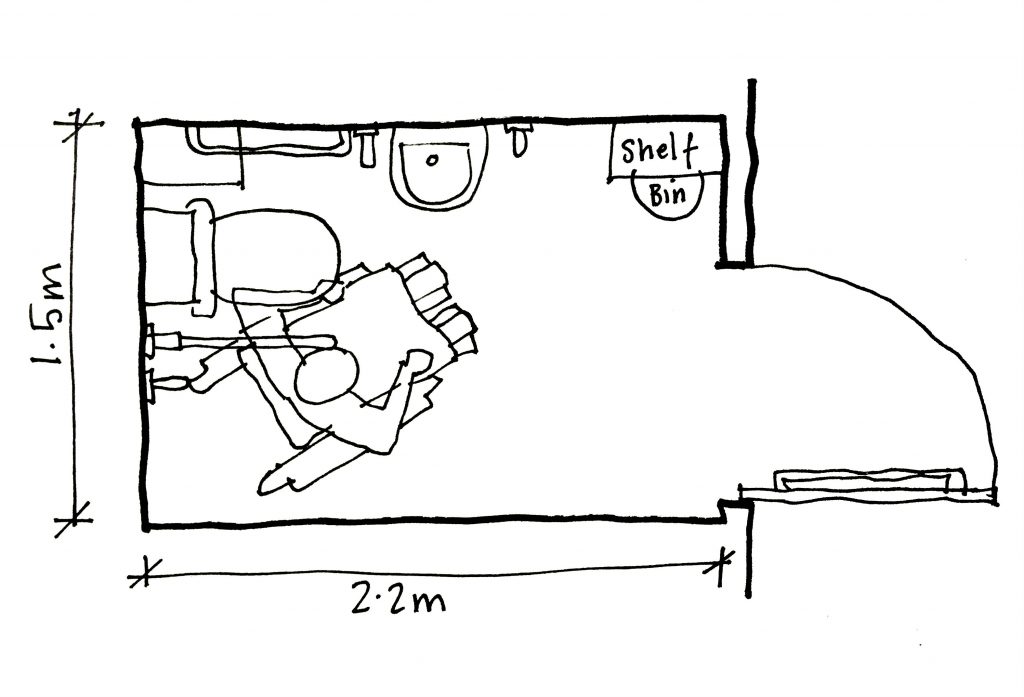
Architects and developers all know this little diagram of a unisex wheelchair accessible toilet from part M of the building regs.
There’s lots of info about the design of this loo, the minimum dimensions, the positioning of sanitaryware and fittings which are all critical to enable a wheelchair user to transfer to the loo and (maybe just?) enough space for a carer to assist an ambulant disabled person to use the loo.
It’s automatic to include this accessible toilet in our designs now (of course it’s part of legislation so we have to, but) it’s inclusion isn’t it? Everyone has to go to the loo so we need to make sure that where there are toilets, there’s a facility for everyone, right? Well, actually, no.
 The thing is, this ‘unisex accessible wc’ is actually pretty small when it comes to using them in a wheelchair, particularly a motorized chair (check out your nearest one!), and impractical (if not impossible) if you are not able to transfer on your own or can’t stand up to change an incontinence pad.
The thing is, this ‘unisex accessible wc’ is actually pretty small when it comes to using them in a wheelchair, particularly a motorized chair (check out your nearest one!), and impractical (if not impossible) if you are not able to transfer on your own or can’t stand up to change an incontinence pad.
It seems so obvious to me now, when I really look at that drawing, and see the compact little wheelchair drawn neatly next to the loo.
My 5.5 year old daughter needs assistance with personal care. She wears nappies/pads. She outgrew ‘baby change’ tables long ago and yet cannot use this accessible loo. What do we do? Where can she change? (I refuse to entertain the idea of laying her on the floor!).
Sometimes (if we ask) we may be offered the first aid room. Which for us is doable as EJ is still small enough for me to lift without a hoist, and we don’t need the use of a toilet – but this is discretionary and not a permanent solution.
So most often we go home – we cut our trips to the length of time it’s reasonable between nappy changes – we are timetabled and our lives restricted by the toilet. Or, if it’s not possible to go home, we might change her in the car (not very dignified, or practical, especially as she grows older).
So many people end up with no choice but to change their loved ones on that small area of floor in the ‘disabled loo’.
People don’t really talk about their toilet needs, or the needs of those they care for – it’s all a bit embarrassing and many people just make do or stay home – so I think the lack of facilities is just a case of not knowing there is a need, unless you have the need, and a lack of joined up policy that we (society) are only just starting to catch up with.
I’m ashamed to admit that working as an architect (pre-children) I didn’t put two and two together. I worked in housing mostly, including extra care housing, where we designed accessible homes with space for carers, bath and shower rooms with ceiling hoists etc, but it really didn’t occur to me that those sorts of facilities wouldn’t be provided for people when they’re out and about!
The best practice standards for Changing Places toilets were conceived to address these needs. A CPT is essentially a larger room, with space enough to accommodate a large wheelchair/scooter, 2 carers, a changing bench and a ceiling hoist (in addition to toilet and wash basin).
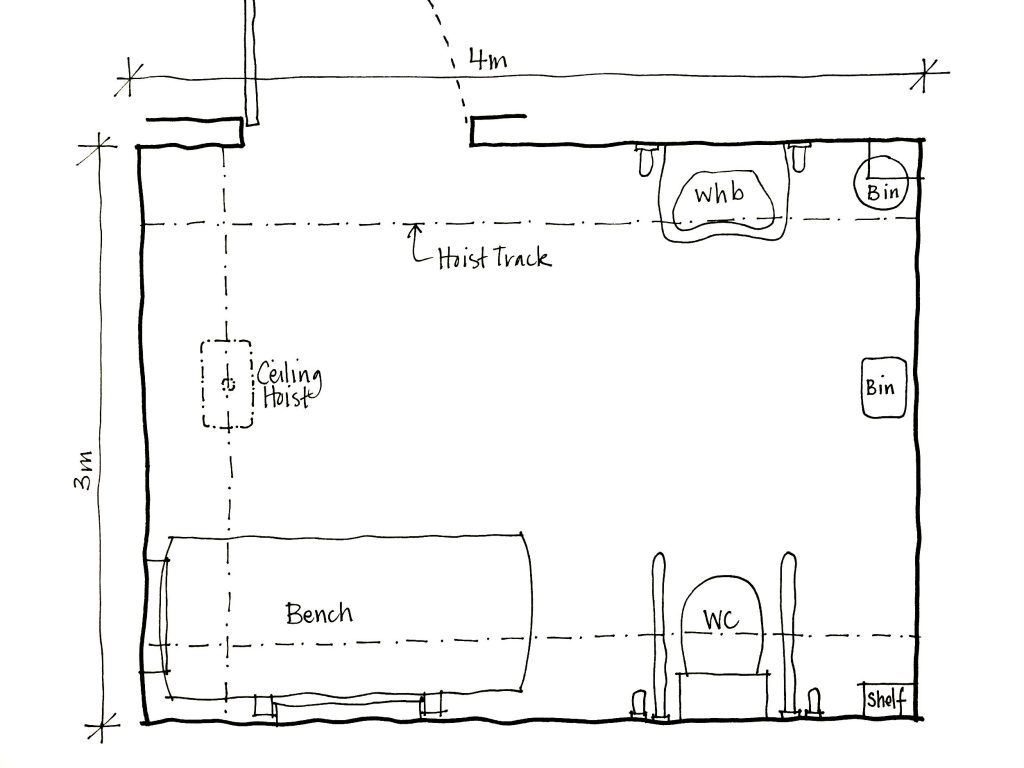
The Changing Places campaign has just celebrated it’s 10th year, and in that time the Changing Places toilet best practice standards have been included in BS 8300:2009 (section 12.7) and referenced in Part M of the building regs. However, despite official acknowledgment of this need, it’s still not compulsory for ANY building to install a changing places toilet, irrespective of building use or occupant capacity. I think this is a huge deal, because when something is only recommended it implies it is ‘not essential’ – however to those of us who need them, they really ARE essential! There’s also a huge potential to miss recommendations completely, when already juggling the complexities of all the complusory regulations in a large building project.
There are now over 850 registered Changing Places in public places and venues across the UK, which is both exciting (given that from nothing the campaign has had 850 successes) and also shocking (in that there are only 850 toilets in the WHOLE of the UK that my daughter can use!). For example there are only 2 CPTs listed in the whole of our home city of Cambridge! One at Addenbrookes Hospital, and the other in the Grand Arcade shopping centre – I would hope more places in Cambridge would welcome disabled visitors than that, but how far is it reasonable to travel away from the only toilet you can use?
It does have to be acknowledged that Changing Places toilets do require a significant amount of space and, understandably, to many smaller individual retailers/venues & in refurbished buildings the degree of space and cost required can be quite a commitment. However if your project is smaller, or existing building too awkward, to accommodate a BS standard changing places toilet, please don’t dismiss the idea! There are other options for upgrading the standard facilities and it is definitely worth speaking with access consultants or the CP consortium to help you get the best out the space available.
My own view is that in smaller venues, particularly those with a family friendly ethos, should be looking to provide more inclusive ‘family facilities’ – perhaps where they’d currently provide a baby change area, one that would provide space for all, from babies to grannies (and everyone inbetween) who need help to use the loo. Something in the spirit of these proposals by the Space to Change campaign. (Note: if thinking of combining facilities, care has to be taken to ensure the needs of those currently met by the ‘unisex accessible WC’ are not compromised).
As an architect passionate about inclusive design, I’m hoping that we can encourage our clients to see the positive impact in upgrading their toilet facilities. Make those ‘reasonable adjustments’, asked for by the Equality Act, and make buildings welcoming and inclusive for all.
 Often the focus of discussion around ‘more standards’ can become negative. Quite understandably, clients are concerned about cost, loss of area & sometimes security…. however aside from the improved sense of inclusion around their business, there is the huge potential increase in patronage by disabled customers (and not forgetting their friends and family!), if the facility is effectively promoted and well integrated in the design to ensure good security.
Often the focus of discussion around ‘more standards’ can become negative. Quite understandably, clients are concerned about cost, loss of area & sometimes security…. however aside from the improved sense of inclusion around their business, there is the huge potential increase in patronage by disabled customers (and not forgetting their friends and family!), if the facility is effectively promoted and well integrated in the design to ensure good security.
Research tells us the purple pound represents billions to our economy! People with greater accessibility needs, families like ours, want to get out and about and enjoy our built environment, socialise, spend money as much as the next person!
Where EJ can’t go, then we can’t go, so we will choose to go to the shopping centre, restaurant, cinema, tourist attractions where we know our child, friend, partner, parent can use the loo comfortably – We will stay there longer, and we will spend more money!
I’d like to end with this link to a fab blog by fellow changing places campaigner @ordinaryhopes who, I think, really illustrates the challenges our built environment presents us with, and one of my favourite quotes from one of her posts:
“At the end of the day, it isn’t really about the toilet. Nobody goes to a theme park just to use their toilet. We want to be able to use their toilet so that we can go to the theme park”
check out the toilets
Have you ever considered how wheelchair accessible the average ‘disabled toilet’ might be? Next time you are out at a café, shop, cinema, or even in your office, check out the toilet (even better take a friend or colleague and an office chair, or wheelchair if you have one, and do a bit of role play! – I’d especially love for building developers, designers and facilities managers to try this!)…..

Now open the door…..
- Could you wheel a chair into the room? Is there space around loo for the chair so that you (the seated person) could transfer to the loo (some people prefer to transfer from the side and some from the front)? There’s not a bin in the way is there? That’s a very common frustration! Or a mop, hoover or even spare office supplies!? More common than you would imagine! If you can – brilliant! – that’s a tick from many part time wheelchair users and full time wheelchair users able to self transfer.
- However, now imagine you cannot transfer to the loo on your own. You may be able to stand and weight bear so perhaps your friend (carer) could help you? Is there enough space to do that? With the chair in there too…. and the door closed? A bit of a squeeze? But what if you cannot weight bear? Can your friend help you get over to the loo? Is there a ceiling hoist? A portable hoist? If not is it safe for them to lift you from chair to loo!? Probably not.
- Finally imagine you wear an incontinence pad and cannot stand up to change. What do you do? Is there a changing bench big enough for you to lie on? A hoist? If yes – brilliant! Gold star! If no, what do you do? Are you prepared to be lifted by your friend out of your chair to lie on the floor? And is your friend happy to lift you, another adult!, on a slippy toilet floor, lower you onto the floor and then kneel down on said floor to help you to change? I suspect not…!
The solution to scenarios 2 & 3 would be a #ChangingPlaces Toilet (as well a whole range of other scenarios for which changing places are the solution too). A toilet with a changing bench and hoist and a bit more floor space that can accommodate a wheelchair user, their wheelchair (some electric wheelchairs in particular are lot larger than the compact one shown in the above sketch!), plus 1 or 2 carers to move around comfortably. Have a look at the map on the Changing Places Consortium website to see where the nearest one to you is. Chances are it’s not very close! As I sit writing this, google maps tells me the closest one to me is 2.5 miles!
Would you travel that far to use the loo!?
No neither would we, so we have to go home or change our daughter in the car. However there is so often no choice for people but to use that small, uncomfortable, dirty toilet floor…..
BareFootChallenge
I’m a little bit late with this one, as usual, but what’s a couple of months between friends eh?! – it’s still a very important message to get out and the Changing Places campaign, which the #barefootchallenge is all about highlighting, is very much alive!
So this is a post all about toilets, which, let’s face it, are a necessary thing in everyone’s lives! But for our little girl (and many, many other children & adults) the right kind of toilet facilities are just not normally available.
Twinkle is now 5.5 years old and is not able to use a toilet, so she wears nappies/pads. Twinkle cannot stand without support so, for the time being, she has to be changed lying down. Although very slim for her age, she’s also very tall and outgrew the little baby change tables long ago. Since then, we’ve been very limited on where she can be changed comfortably, hygienically and with at least some amount of dignity.
The usual options for her are:
- Lie down on a public toilet floor. A room that (even the wheelchair accessible ones) don’t have space for a wheelchair, a person lying down and a carer all at once without squashing up against toilet bowls or sanitary bins. (I myself have OCD so the very idea of putting my little girl in this position, quite frankly, freaks me out!)
- Perch precariously on the baby change table (which we sometime still manage to do, some are bigger than others),
- Change in the car (which we quite often resort to doing!) or
- Limit the time we are out and about to avoid changing at all.
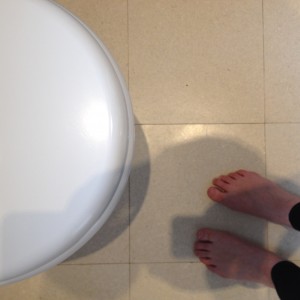 The #barefootchallenge was started on Twitter (@barefootoffical) by a fellow mum to raise awareness of the inadequacy of current facilities.
The #barefootchallenge was started on Twitter (@barefootoffical) by a fellow mum to raise awareness of the inadequacy of current facilities.
The challenge being:
Can you bring yourself to put your own bare feet on a public toilet floor?
If you struggle with that, imagine having to lie down on one like many children and adults with disabilities have to!?
As you can see from my challenge picture, my answer was NO! I had to do my challenge in my own loo!
The easy solution to this issue is for more large public buildings and venues to install a Changing Places toilet! A facility with more space for carers, a height adjustable changing bench and a hoist.
I am ashamed to admit, until Twinkle started to outgrow the standard baby change facilities it hadn’t really occurred to me that alternatives to the standard disabled toilets were needed. I hadn’t heard of Changing Places toilets. This is pretty shocking because until I had children I worked in architectural practice. I worked in housing so I knew a whole raft of other care design standards (e.g. lifetime homes, wheelchair design guide….), but not changing places. I know it’s a relatively new standard (to solve a very old problem!) but I would have thought I would at least have heard of it even if not used it in my projects?! Which makes me wonder how many of my fellow architects know of it, and know just how much a difference it could make?
Changing Places toilets do get a brief mention in the Building Regulations, but disappointingly (despite the Disability Discrimination Act (1995) and the more recent Equalities Act (2010)) they’re still not a requirement in any category of building, just a recommendation:
“In large building developments, separate facilities for baby changing and an enlarged unisex toilet incorporating an adult changing table are desirable. Facilities incorporating adult changing tables are more commonly known as Changing Places Toilets and further guidance is available from the Changing Places Campaign website (www.changing- places.org) or by reference to guidance in section 12.7 and Annex G of BS 8300.” – Building Regs M Vol 2 (M3 5.6)
I’d say this is a pretty fundamental piece of inclusion lacking from legislation.
Thankfully the Changing Places campaign is starting to gather momentum, and they have recently launched a fantastic new map showing the locations of UK Changing Places. It even has a journey planner element (a very useful feature!). The map also sadly highlights just how few and far between these facilities are (although I’m secretly hoping there are more than shown, and just not registered…?). For example our own visitor/tourist hotspot city, Cambridge, only has 2 changing places listed! One of which is at the hospital – a location that the average day-tripper or holiday maker doesn’t normally intend to put on their destination list!
A friend at the Firefly Friends community forum, for parents of children with special needs, has also launched a campaign parallel to the Changing Places campaign – Space to Change. Space to Change was set up to try and encourage other smaller venues, who maybe don’t have the funds or the space to install a fully compliant changing places facility, to at least improve what they have and provide more accessibility for a greater range of needs. Perhaps install a fixed bench in a larger WC cubicle which would at least provide a more comfortable & hygienic space to lie down, and also make the transfer from wheelchair much easier than the floor!
So! Would you stand on a public toilet floor in your bare feet or lie down on the floor?
If not, then please spread the word about the need for Changing Places toilets!
Edited (30.03.16) to add:
And you can add your name to this petition calling for Changing Places to be requirement and not just recommendation!
